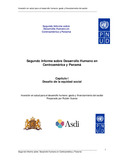Mostrar el registro sencillo del ítem
Inversión en salud para el desarrollo humano: gasto y financiamiento del sector
| dc.contributor.author | Suárez, Rubén | |
| dc.date.accessioned | 2017-11-04T23:39:31Z | |
| dc.date.available | 2017-11-04T23:39:31Z | |
| dc.date.issued | 2003 | |
| dc.identifier.uri | https://hdl.handle.net/20.500.12337/800 | |
| dc.description | Ponencia presentada como investigación base para el INFORME ESTADO DE LA REGIÓN 2003 (no. 2) | |
| dc.description.abstract | The countries of the Region are heterogeneous in terms of the living standard of the population; as measured by the level of income per capita, HDI, levels of education, health status and other socioeconomic indicators. They are even more heterogeneous in terms of the amount of resources invested in health; as measured by the level of national health expenditures, and in the Public/Private composition of those expenditures. Large variations in the level national health care expenditures (NHE), in the importance of NHE as percentage of the Gross Domestic Product (GDP) and in the public-private composition of national health expenditures are closely related to different ways in which national health care systems are organized and financed. Countries with better health outcomes – life expectancy, maternal mortality and infant mortality rates and HDI are those in which there is a larger participation of the public sector in organizing and financing national health care systems. These are countries in which public expenditures as percentage of the GDP is significant higher than that of other countries of the region and/or countries with extended social insurance schemes (coverage of population and services). | es_US |
| dc.language.iso | es | es_US |
| dc.publisher | San José, Costa Rica: PEN | es_US |
| dc.rights | acceso abierto | es_ES |
| dc.subject | AMÉRICA CENTRAL | es_US |
| dc.subject | ACCESO A LA SALUD | es_US |
| dc.subject | SISTEMA DE SALUD | es_US |
| dc.title | Inversión en salud para el desarrollo humano: gasto y financiamiento del sector | es_US |
| dc.type | informe de investigación | es_US |

